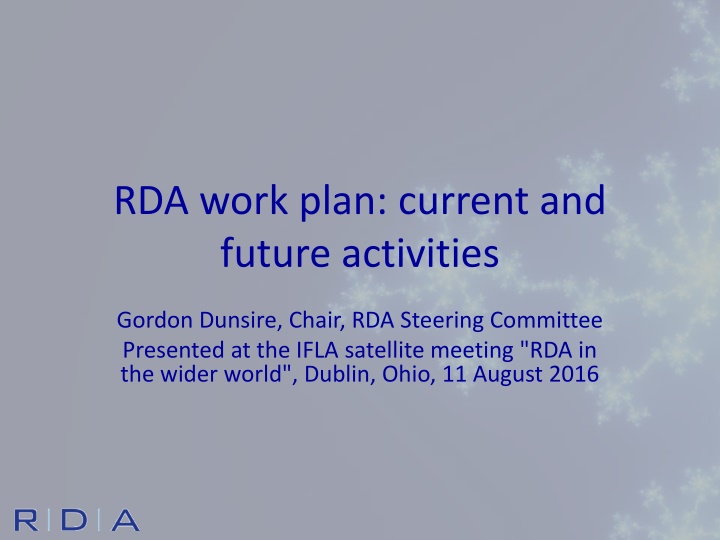
RDA Development and Infrastructure Overview
Explore the current and future activities driving the development of RDA (Resource Description and Access), including strategies for community development, use of linked data and Semantic Web, consolidation of FRBR models, and more. Learn about RDA content infrastructure, reference data maintenance, glossary updates, and the new RDA Terms vocabulary encoding scheme.
Download Presentation

Please find below an Image/Link to download the presentation.
The content on the website is provided AS IS for your information and personal use only. It may not be sold, licensed, or shared on other websites without obtaining consent from the author. If you encounter any issues during the download, it is possible that the publisher has removed the file from their server.
You are allowed to download the files provided on this website for personal or commercial use, subject to the condition that they are used lawfully. All files are the property of their respective owners.
The content on the website is provided AS IS for your information and personal use only. It may not be sold, licensed, or shared on other websites without obtaining consent from the author.
E N D
Presentation Transcript
RDA work plan: current and future activities Gordon Dunsire, Chair, RDA Steering Committee Presented at the IFLA satellite meeting "RDA in the wider world", Dublin, Ohio, 11 August 2016
What drives RDA development? Strategy to develop RDA communities International Cultural heritage (archives, museums) Linked data and Semantic Web Consolidation of FRBR models in FRBR-LRM Development of related standards, e.g. ISBD, ISSN Re-organization of Toolkit structure and functionality
RDA content infrastructure RDA Reference data is used in several RDA services, not just RDA Toolkit RDA entities, relationships, designators, vocabulary encoding schemes + translations RDA Reference content has open CC0 license New development of content management infrastructure reduces duplicate updating in multiple services
RDA Reference data maintenance and flow RDA editors: Secretary Translators Open Metadata Registry RDA/RDF Developers RDA Vocabularies (GitHub) Developers RDA RDA Toolkit Glossary RDA Registry RIMMF3 Vocabulary Server Developers Trainers Applications Cataloguers
RDA Reference in Toolkit Glossary Expanded Glossary is a listing of all entries, definitions, scope notes, and cross-references in RDA Reference New vocabulary encoding scheme for terminology used in RDA instructions Many terms included in previous Glossary Now managed as a separate vocabulary: RDA Terms
"access point" in Open Metadata Registry Possibility of map between RDA Terms and MulDiCat
Impact of LRM More entities (Nomen, Place, Time-span, Agent, Collective Agent) From attributes to relationships RDA as a refinement of LRM high-level entities, attributes, and relationships The four-fold path Unstructure description, structured description, identifier, URI: for related entities.
FRBR-LRM and RDA LRM a high-level conceptual model intended as a guide or basis on which to elaborate cataloguing rules RDA guidance, instructions, elements operates at a greater level of generality than FRBRoo, which seeks to be comparable in terms of generality with CIDOC CRM RDA cultural heritage communities LRM this model is developed very much with semantic web technologies in mind RDA linked data communities
FRBR-LRM and RDA entities Any Thing: Covers all other types of thing Res has appellation Nomen is created by W E Agent Place is type of M I is associated with Collective agent is modified by Timespan P F C
RDA refines LRM Coarse/General is associated with Res1 Res2 A W has creator has artist Fine/Specific is associated with Res1 Res2 E E is derivative (E) is adapted as (E) is adapted as graphic novel (E)
From attributes to relationships has manifestation statement Publication statement Transcribed has place of publication Nomen Place has publisher s name C Nomen M Recorded Timespan Nomen has date of publication
The 4-fold path The 4-fold path supports catalogue cards, flat file schema, RDBMS, and linked data (RDA database implementation scenarios) Describing a related entity: Unstructured description Structured description Identifier URI General guidance and instructions: Simple Less duplication Easier to translate
Conclusion There's a lot of work to plan and do We have made a good start with the RDA Reference infrastructure The next 2-3 years will bring about many more changes We hope you will work with us to make RDA Toolkit and other services the best they can be
Thank you! rscchair@rdatoolkit.org RDA Steering Committee http://www.rda-rsc.org/ RDA Toolkit http://www.rdatoolkit.org/ RDA Registry http://www.rdaregistry.info/ Open Metadata Registry http://metadataregistry.org/ RIMMF http://www.marcofquality.com/wiki/rimmf3/
